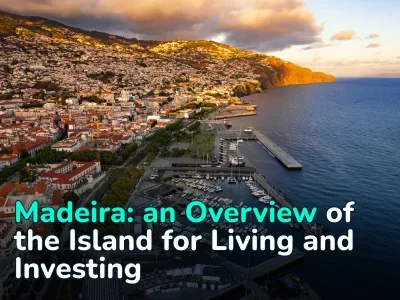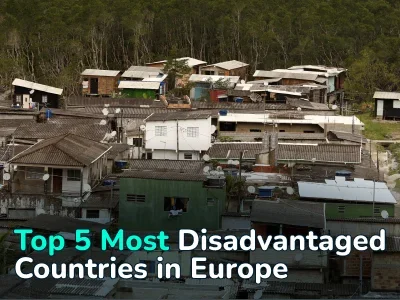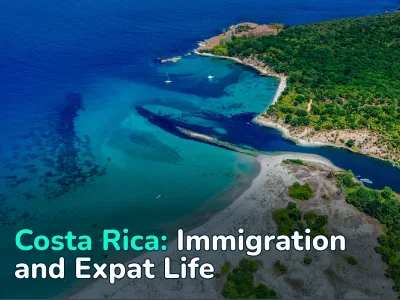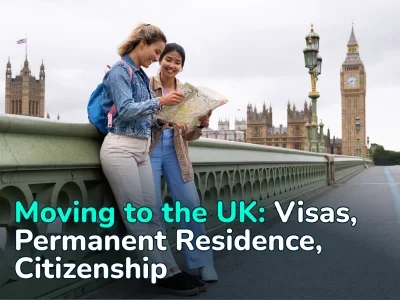
Top 5 Countries for Obtaining a Retirement Residence Permit
Retirees belong to a segment of the population that no longer needs to work. They are not tied to the country from which they receive their pension and can choose another country for permanent residence. Some countries around the world are interested in attracting such individuals because retirees do not take jobs from the local population — they simply spend money.
For a government, this is an easy way to direct foreign currency into the local economy. Achieving a similar effect in trade would require exporting more goods than importing, whereas here, it’s simply a matter of attracting retirees.
In this article, we will look at countries that offer retirement residence permits and examine various factors relevant to relocating there.
Criteria for Selecting a Country for Retirement
The main criterion is whether the country has a dedicated residence permit program for retirees. Most countries that offer such programs require proof of stable income (usually a pension), reaching a certain age (typically 50–55 and above), and a minimal set of documents. This is a key factor, as it determines how accessible the relocation process will be.
A second important factor is the cost of living. If a retiree moves to a country where the cost of living — and therefore goods and services — is higher, their pension will stretch significantly less than it would in a more affordable location. The opposite is also true: retirees with higher incomes often seek countries with a lower cost of living than their home country.
Additional selection criteria:
- Healthcare. The quality of medical services is a critical consideration for older adults.
- Climate conditions. A mild climate is preferable for people with chronic conditions such as arthritis.
- Crime rate. The safer the country, the better.
- Political stability. It is better to choose a country with a stable political environment and no signs of unrest.
- Language barrier. Countries where English is widely spoken offer easier adaptation, especially before acquiring basic proficiency in the local language.
- Pension taxation. The ideal scenario is one where foreign pensions are not taxed by the host country.
Top 5 Countries for Retirees
The most popular destinations in Europe are Portugal and Spain. These countries are frequently chosen by affluent retirees from the UK, the USA, Germany, and Scandinavian countries. The reason is simple: these retirees typically receive high pensions and can afford European prices.
A more budget-friendly alternative is Latin America. However, English is less commonly spoken there, and political systems in many countries lack long-term stability. Thailand stands apart — its government is open to foreign arrivals, and the relatively low cost of living, combined with its focus on foreign residents, makes it a potentially attractive option.
Portugal
Portugal is one of the most popular European countries for retirees. It offers the D7 visa program, which allows foreign nationals to obtain a residence permit based on stable passive income.
The main requirements include:
- Minimum income. Applicants must prove a monthly passive income of at least €870 for a single person (about €10,440 per year). For a couple, an additional 50% is required (€435 per month for the second person), bringing the total to approximately €1305 per month. For each child or dependent, 30% of the base amount is added (€261 per month).
- Bank account. The applicant must open an account in a Portuguese bank and transfer funds equivalent to the minimum annual income requirement (€10,440 for one person, €15,660 for a couple) to demonstrate financial solvency.
- Housing. Proof of accommodation is required — either a rental agreement or property ownership documents (no specific value threshold is set).
- Documentation. Applicants need to provide a passport, a criminal background check, health insurance, proof of income, and marriage or birth certificates (for dependents). All documents must be translated into Portuguese and officially certified.
The D7 visa is initially valid for 4 months. During this period, the applicant must enter Portugal and apply for a residence permit through the Agency for Integration, Migration and Asylum (AIMA). The entire process typically takes 6 to 12 months. To maintain resident status, one must stay in the country for at least 183 days per year. After 5 years of legal residence, it is possible to apply for permanent residency or citizenship.
Pros of living in Portugal for retirees:
- Mild climate. Portugal has a Mediterranean climate with around 300 sunny days per year. Average winter temperatures range from +10°C to +15°C, and summer temperatures range from +25°C to +30°C. The Azores offer a milder summer (+22°C to +25°C), though with very strong winds.
- Affordable cost of living. According to Numbeo, average monthly expenses for one person (excluding rent) are between €670 and €800, lower than in Germany (€1000) or France (€900). A one-bedroom apartment in Lisbon costs €800—€1200, while in the suburbs it ranges from €600—€800. A comfortable monthly budget for a couple is around €1200—€2000.
- High-quality healthcare. Portugal ranks in the top 20 globally for healthcare quality. Public clinics offer free medical services to residents, including retirees.
- Safety. Portugal ranks 7th in the Global Peace Index, making it one of the safest countries in the world.
Cons of living in Portugal for retirees:
- Language barrier. While English is widely spoken in tourist areas, dealing with government offices or living in smaller towns requires at least basic Portuguese (level A1—A2).
- Bureaucracy. The administrative system can be slow and cumbersome, requiring numerous documents and frequent visits to government offices.
- Climate-specific issues. High humidity during the winter in coastal cities and the lack of central heating in most homes can be uncomfortable for elderly residents. Summers can also be very hot, reaching up to +40 °C.
- Payment limitations. International Visa/MasterCard cards are not accepted everywhere, so it’s advisable to obtain a local bank card or carry cash.
- Taxation of pensions. Foreign-source income, including pensions, is subject to taxation in Portugal. However, a double taxation treaty typically applies, meaning taxes already paid in the pension’s country of origin can be credited against Portuguese taxes, and only the difference needs to be paid.
Spain
Spain ranks second in popularity among retirees relocating abroad, just behind its neighbor Portugal. Its Non-Lucrative Visa (NLV) program is designed for financially independent individuals and is well-suited for retirees, as it does not permit employment in the country. Key requirements include:
- Minimum income. The applicant must prove a passive income of at least 400% of the IPREM (Indicador Público de Renta de Efectos Múltiples), which in 2025 is €600 per month. This means a minimum monthly income of €2400 (€28,800 annually) for a single applicant. For a spouse or dependent, an additional 100% IPREM (€600 per month) is required, making it €3000 per month for a couple.
- Financial savings. To confirm financial independence, it is recommended to show savings in a bank account — for example, between €28,800 and €57,600 for an individual or a couple, respectively. The account may be held in any country, though it is preferable to use a Spanish bank.
- Health insurance. A private health insurance policy from an accredited Spanish company is mandatory (costing approximately €50—150 per month for retirees).
- Housing. Proof of accommodation is required, either through a rental contract (€600—1200 per month, depending on the region) or property ownership documents. There is no minimum property value requirement.
- Documentation. Required documents include a passport, a criminal background check (with apostille and Spanish translation), a medical certificate confirming the absence of contagious diseases, proof of income, an application form, and a cover letter. All documents must be translated into Spanish and certified.
The NLV application must be submitted at the Spanish consulate in the applicant’s country of residence. The processing time is usually 1–3 months. Within 30 days of entering Spain, the applicant must apply for a residence card (TIE) at the local immigration office. To maintain residency, one must live in Spain for at least 183 days per year. After 5 years, one can apply for permanent residency, and for Spanish citizenship after 10 years.
Pros of living in Spain for retirees:
- Warm climate. Spain’s climate is similar to Portugal’s, although inland regions have average summer temperatures of +25 °C to +32 °C. The dry air is beneficial for people with upper respiratory conditions.
- Well-developed healthcare. The public healthcare system is free of charge. Private clinics offer consultations for €50—100 per visit.
- Safety. Spain ranks 29th in the Global Peace Index. While lower than Portugal, it is still considered a very safe country.
- Affordable cost of living. Average monthly expenses per person (excluding rent) are around €650—850. Renting a one-bedroom apartment in major cities like Madrid or Barcelona costs €800—1300; in smaller cities, it costs €600—900. A comfortable monthly budget for a couple is approximately €1500—2500.
- Cultural richness. Spain boasts a vast number of museums, many of which offer free admission for residents aged 65 and above.
Cons of living in Spain for retirees:
- Language barrier. Spanish is essential for dealing with government agencies, healthcare providers, and daily life, particularly outside of tourist areas.
- High cost of living. Groceries alone cost about €200—300 per month for one person or €350—450 for a couple. Utilities add another €80—150 monthly, excluding rent.
- Bureaucracy. The residency and registration processes are often time-consuming due to long queues and the requirement for certified document translations.
- Taxes. Foreign pensions are subject to Spain’s progressive income tax, which ranges from 19% to 47%. However, bilateral tax treaties usually apply. For example, if your pension is taxed at 15% in your home country and Spain’s rate is 19%, you only need to pay the 4% difference in Spain.
- Summer heat. In southern regions such as Andalusia, summer temperatures can reach +40 °C, which may be difficult for older individuals to tolerate.
Mexico
The Residente Temporal program allows retirees to obtain a temporary residence permit in Mexico for up to 4 years, with the option to renew or transition to permanent residency (Residente Permanente).
The main requirements are:
- Minimum income. The applicant must demonstrate a monthly income of at least 500 times the daily minimum wage in Mexico City (approximately $115/month). In practice, Mexican consulates typically require proof of income between $1500 and $2000 per month for a single applicant (around $18,000–24,000 annually).
- Financial savings (alternative). Instead of monthly income, applicants may show savings equivalent to 20,000 times the daily minimum wage (approximately $17,000–20,000) held in a bank account.
- Documentation. Required documents include a passport, bank statements or a pension letter, a criminal background check (not always required), a medical certificate (sometimes required), photographs, and an application form. All documents must be translated into Spanish and legalized with an apostille and submitted to a Mexican consulate in the applicant’s home country.
The consulate typically issues the visa within 1–2 months. Upon arrival in Mexico, the applicant must register with the National Institute of Migration (INM) within 30 days to receive a resident card. There is no strict requirement to spend 183 days per year in Mexico, but absences of more than 6 consecutive months may complicate renewal.
Pros of living in Mexico for retirees:
- Low cost of living. Mexico is one of the most affordable retirement destinations. Average monthly expenses per person, excluding rent, range from $350 to $500. Rent adds another $300–700, making the total cost for a couple about $800–1500 per month for a comfortable lifestyle.
- Warm climate. The country offers diverse climates, where it is tropical along the coasts and temperate in the highlands. It allows retirees to choose cooler areas without extreme summer heat.
- Affordable healthcare. Mexico offers both public and private healthcare. Private clinics meet international standards and cost 3–5 times less than in the U.S. Public healthcare is available to residents for about $400–600 annually. Overall, medical care quality is comparable to that in the U.S.
- Proximity to North America. Direct flights to the U.S. and Canada (2–3 hours, typically $100–300) make Mexico a convenient base for retirees with family or interests in those countries.
- Retiree discounts. After obtaining residency, individuals over 60 can apply for an INAPAM card, which offers discounts of 10–50% on transportation, healthcare, dining, and cultural activities.
Cons of living in Mexico for retirees:
- Security concerns. Mexico has a high crime rate. However, cities popular with expatriates are generally considered safe and well-monitored.
- Language barrier. Spanish is essential for interacting with government offices and for everyday life, especially outside of tourist zones.
- Climate. Coastal areas can be uncomfortably hot and humid, with hurricane seasons posing additional risks. Highland regions offer drier weather, but their high altitude can cause breathing difficulties for some seniors.
- Infrastructure limitations. Outside major cities and tourist areas, poor road conditions, lack of accessibility features (like ramps), and unreliable internet are common issues.
Thailand
Thailand actively attracts foreigners from Europe, North America, and Australia through its Non-Immigrant O-A (up to 1 year) and O-X (5–10 years) visa programs, both specifically designed for individuals aged 50 and above. The main requirements are:
- Age. Applicants must be over 50 years old.
- Minimum income. For the O-A visa, a monthly income of at least $1900 is required. For the O-X visa, the required annual income is $88,000. Alternatively, applicants may demonstrate savings in a Thai bank account: at least $23,500 for O-A and $88,000 for O-X.
- Health insurance. O-A visa insurance must cover at least $1200 for outpatient treatment and $11,800 for inpatient care. O-X visa coverage must total $88,000 for the entire visa duration, with monthly premiums typically ranging from $100 to $500.
- Documents. Required documents include a valid passport (minimum 18 months for O-A, 5 years for O-X), a bank statement, a pension or income certificate, a medical certificate (confirming absence of tuberculosis, syphilis, and other communicable diseases), and a criminal background check. All documents must be translated into English and submitted to a Thai consulate.
The O-A visa is usually issued within 1–2 months, and the O-X visa within 2–3 months. Upon entry, the holder must register with the Thai Immigration Office and renew the visa annually. Residence must be reported every 90 days. After 5–10 years, applicants can apply for long-term extensions, but obtaining permanent residency or citizenship in Thailand is extremely difficult, regardless of visa type.
Pros of living in Thailand for retirees:
- Low cost of living. Average monthly expenses for one person (excluding rent) range from $350 to 550. Monthly rent for a one-bedroom apartment costs $200–400 in Chiang Mai, $300–600 in Phuket, and $400–800 in Bangkok.
- A comfortable monthly budget for a couple is $800–1500.
- Tropical climate. Thailand is warm year-round (+25°C to +35°C), though high humidity is constant.
- High-quality healthcare. Many private hospitals rank among the top 100 globally. Specialist consultations cost $20–50, and MRI scans range from $300–500. It is 3 to 5 times cheaper than in the U.S. or Europe.
- Regional travel accessibility. Affordable flights to nearby countries like Malaysia and Vietnam cost $50–15, making regional travel easy and economical.
Cons of living in Thailand for retirees:
- Language barrier. The Thai language is complex, and English is mainly spoken in tourist areas. For daily life and administrative tasks, basic Thai is often necessary.
- Security. Thailand ranks 92nd in the global crime index. While tourist areas are generally safe, petty theft and scams are common.
- Limited long-term prospects. Thailand does not offer permanent residency or citizenship to retirees, regardless of how long they live in the country.
- Infrastructure disparities. While tourist cities offer senior-friendly infrastructure (ramps, public transport), rural areas often suffer from poor road conditions and unreliable internet.
Ecuador
The government of Ecuador offers the Pensionado Visa for individuals with verifiable pension income. It is one of the most accessible retirement visa programs due to its low entry threshold.
The main requirements are:
- Minimum income. Applicants must demonstrate a stable monthly income of at least $450. For a spouse or dependent, an additional $225 per month is required, totaling around $675 for a couple.
- Documentation. Required documents include a valid passport (with at least 6 months of validity), a certified pension statement (with apostille), a criminal background check (also apostilled and translated into Spanish), a medical certificate confirming the absence of infectious diseases, a completed application form, and passport-sized photographs.
- Housing. Proof of rental or owned accommodation is required only at the time of visa renewal.
Pros of living in Ecuador for retirees:
- Low cost of living. Average monthly expenses for one person, excluding rent, range from $250 to 400. Rent for a one-bedroom apartment is typically $150–300. A reasonable monthly budget for a couple is around $600–1200.
- Stable currency. Ecuador uses the U.S. dollar as its official currency, eliminating exchange rate volatility and simplifying budgeting for retirees with income in dollars.
- Diverse climate. Ecuador features three distinct climate zones: a mild mountainous climate in the Andes, a tropical coastal region, and the humid Amazon rainforest, allowing retirees to choose a location that fits their health and comfort preferences.
- Affordable healthcare. Private clinics offer high-quality medical services at very reasonable prices — doctor consultations cost $15–30, and MRI scans range from $150–300. The IESS public healthcare system is available to residents for $50–100 annually.
- Retiree benefits. After receiving residency, individuals over 65 can apply for a Tercera Edad card, which provides 50% discounts on transportation, utility bills, cultural events, and domestic air travel.
Cons of living in Ecuador for retirees:
- Safety concerns. Ecuador has a moderate crime rate. Cities like Cuenca and Vilcabamba are considered safe, especially by expats, but in Guayaquil and Quito, nighttime robberies and petty crimes are more common.
- Language barrier. Spanish is essential for navigating public institutions and daily life, especially outside tourist-oriented areas.
- Political instability. Ecuador has experienced frequent protests and demonstrations due to political unrest, which may affect public services and overall stability.
- Limited access to specialized healthcare. Outside of major cities, access to specialist medical care is often limited or delayed, posing a challenge for retirees with chronic or complex health conditions.
Frequently Asked Questions
Which countries are the best for retirees in 2025?
The top countries for retirees in 2025 are Portugal, Spain, Mexico, Thailand, and Ecuador.
Which countries offer the easiest residence permit process for retirees?
The easiest country to obtain a retirement residence permit is Ecuador, via the Pensionado Visa program. You only need to prove a minimum monthly income of $450. The application process takes 1–3 months, requires minimal documentation (pension certificate, criminal background check), and is relatively straightforward.
Mexico ranks second — applicants need either a monthly income of $1,500–2,000 or savings of $17,000. Processing time is typically 2–4 months. In comparison, European and North American countries have the most bureaucratic and time-consuming processes.
Which countries have the lowest cost of living for retirees?
In the budget category, Ecuador leads, with a total monthly cost for a couple ranging from $400 to $1200. Similar prices can be found in other Latin American countries, excluding Argentina and Brazil, where inflation and cost of living are higher. In Asia, the best value is offered by Thailand, where monthly expenses for a couple range from $500 to $1500, depending on the region and lifestyle.
Author
I write informative articles about real estate, investments, job opportunities, taxes, etc.






















